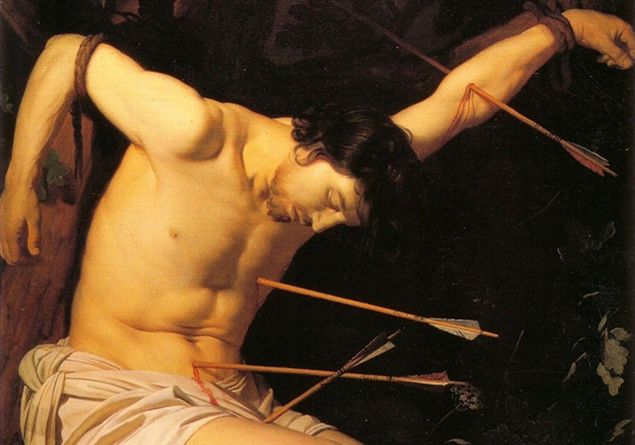Native of Narbonne, citizen of Milan, high and highly esteemed officer of the praetorian guard of Diocletian and Maximian, Sebastiano is the hero of Militia Christias a soldier and as a defender of the faith.
From the Depositio Martyrumin the Chronograph of 354, an almanac which contained, among other things, lists of saints with the dates of their martyrdom, we know the day of his death: January 20, and the place of his burial in catacumbasthat is, the catacombs along the Appian Way, on which, in the first half of the 4th century, the great cemetery basilica of San Sebastiano was built, which was then called ecclesia apostolorum.
The year of death is perhaps 288, or more likely 303 or 304. Only Ambrose, among all the Fathers of the Church, mentions Sebastian and the cult dedicated to him, which must have been well developed by the middle of the 4th century, at least in the city. The exploits and passion of miles Christi they are narrated in a hagiographic text from the 5th century, the work of an unknown cleric, and sometimes, improbably, attributed to Saint Ambrose.
Sebastian is therefore in Milan, commander of the first praetorian cohort, de facto the imperial bodyguard, so esteemed by Diocletian and Maximian that the two rulers continually request his presence. However, they are unaware that their favorite is Christian. He conceals his faith to better bring comfort to his persecuted co-religionists and strengthen their desire for martyrdom as a testimony to their belief, when, under torment, it falters.
Jacopo da Voragine narrates in his Golden legend – a compilation of the lives of the saints, written towards the end of the 13th century, very famous in the Middle Ages – that Sebastiano was once in the prison where the twins Marcus and Marcellinus were held prisoner, condemned to death because of their profession of Christianity. Desperate parents showed up and, with ardent words, begged their children to save their lives. They were on the point of giving in, when the officer intervened with authority, restoring in them the steadfastness of their hearts towards the glory of victory over lies and salvation in eternal life. He appeared to those present, surrounded by light and surrounded by seven very bright angels, for a whole hour.
Then Zoe, wife of Nicostrato, an official in whose house the two young people were held prisoner, threw herself at the saint’s feet, begging for forgiveness with gestures, because she was mute. Sebastiano then shouted: “If I am the servant of Christ, and if the words spoken by the One who opened the mouth of Zechariah are true, let the mouth of this woman be opened.” And immediately the mute shouted: “Blessed be your words and blessed be those who believe in them. I saw an angel with a book in front of you where what you said was written.”
Nicostratus, hearing his wife speak, also threw himself at the feet of the saint, and immediately freed the imprisoned martyrs. But Marco and Marcellino, strengthened in their desire for martyrdom by Sebastiano’s words, refused to leave, while their parents and many others were baptized by the priest Policarpo. Sebastian was later denounced to the emperors.
Appearing before Diocletian who, enraged, reproached him for having betrayed his trust, the officer declared that he had actually prayed to God for the salvation of Rome. The emperor condemned him to die at the hands of archers in the middle of the Field of Mars.
His body, all pierced by arrows, was abandoned on the ground and naturally left for dead; but a few days later, the emperor, astonished, saw him appear before him, harshly rebuking all the harm done to the Christians. This time Diocletian commanded that he be whipped to death, and so he was done, and his body thrown into a sewer.so that it would not become an object of veneration for Christians. The following night the saint appeared to Saint Lucia, revealed to her where he was and ordered her to bury him next to the tombs of the apostles.
He narrates it Golden legend that in the history of the Lombards we read of a terrible plague that particularly affected the cities of Rome and Pavia, and it was revealed that the disease would not cease unless an altar was erected to Saint Sebastian, in the church of San Pietro in Vincoli in Pavia. As soon as the altar was erected and consecrated, the disease ended.
Sebastian, a military saint, soon became one of the patron saints of the city of Rome. An important cult developed around the basilica built on the catacombs, which then spread to other places in the city, with the construction of new churchesgenerally in the places mentioned in the Passion of Saint Sebastian. In the 10th century there was perhaps a church dedicated to the saint on the Palatine Hill, in place of the ancient temple of Heliogabalus, on whose steps Sebastiano had stood as accuser of Diocletian.
Outside Rome the cult of Saint Sebastian spread thanks to the distribution of the relics inRoman Africa, Spain, Gaul and Germany.
The holy martyr was invoked above all against the plague, although nothing, in Passion, justify this attitude. The legend of the miracle of Pavia was probably the starting point of this devotion.
The arrows that pierce the saint made him the patron saint of archers, crossbowmen, arquebusiers, but also, no one knows why, stonecutters, upholsterers, blacksmiths, firefighters and gardeners.









